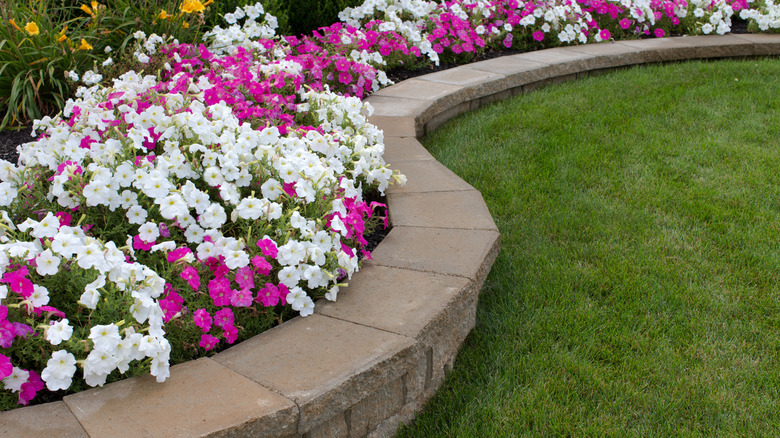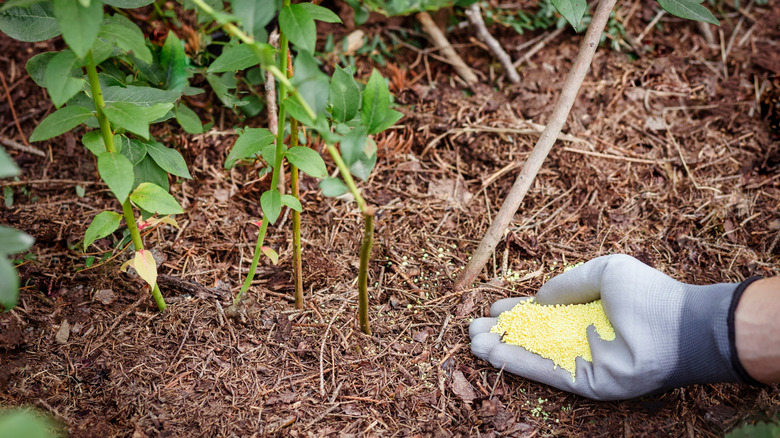Add One Strange Ingredient To Your Garden In Fall For Bigger Blooms In Spring
It's easy to assume that spring is when the real work in the garden begins, but the truth is that healthy soil — and bigger, brighter blooms — start with the right regimen in the fall. While most homeowners might focus on mulching or clearing away debris, the real secret comes in the form of a lesser-known but surprisingly powerful mineral: Sulfur. It might not be as flashy as compost or bonemeal, but this humble element can play a crucial role in improving soil chemistry and ensuring that your plants get the nutrients they need to thrive. And while it might sound strange to toss a mineral that smells faintly of matches into your flower beds, the payoff is certainly noticeable come the next growing season! With the simple addition of sulfur to your fall garden ritual, you will ensure that your plants grow vibrant, massive blooms in the spring.
Using sulfur fertilizer on your garden in the fall gives plenty of time for it to take action. The mineral interacts with soil microbes to gently lower pH levels, creating a slightly acidic environment that certain plants — like azaleas, hydrangeas, and rhododendrons — absolutely love. Even more neutral-soil plants can benefit from the improved nutrient uptake that this mineral helps with, but you should be careful not to lower the pH too much. The process isn't instantaneous and will need a few months to take effect. Applying in autumn gives sulfur the head start it needs before spring growth kicks back into full drive. Think of it as a bit of pre-season training for your soil — one that is quiet and unseen, yet entirely transformative. By the time the first buds appear in spring, you should notice richer colors, bigger blooms, and a noticeable difference in overall plant vitality.
How sulfur can transform your garden from the ground up
Sulfur's effect on soil goes far beyond increasing acidity. Over time, it can work to improve drainage, soil structure, and the delicate microbial balance — all key factors in supporting a thriving population of plants. When added in moderation, it promotes an ecosystem that encourages beneficial bacteria, which in turn helps convert nutrients like nitrogen and phosphorus into a form that plants are actually able to absorb. That's why sulfur has been referred to as the "silent optimizer" of the garden; it creates the right environment for other nutrients to work effectively and efficiently, and helps to promote strong growth. The results? Lusher foliage, sturdier stems, and blooms that look like they've had a professional touch-up, all from a simple ingredient.
However, timing and dosage do matter when adding sulfur to your garden. Fall is the perfect time for application because of the cooler temperatures and winter moisture. This gives the sulfur time to react gradually, avoiding the risk of shocking your plant or burning roots from rapid pH adjustments. Before applying, it's smart to grab a few tools to measure the pH of your soil — a simple home test kit can reveal whether you even need sulfur in the first place. Once incorporated, soil should be left to rest through winter while you let the microbes do the hard work. In spring, there will be a noticeable difference, not just in how your flowers look, but in how effortlessly they grow. Sometimes, all you need to do is break out the chemistry to keep your garden looking lush and vibrant for years to come.
How to add sulfur to your garden and keep it working year round
Applying sulfur is a bit more complicated than just scattering it across your garden beds, so it pays to be strategic. Start by lightly raking your garden beds to loosen the surface soil. Sprinkle a thin layer of powdered or granular sulfur evenly across the area — about one to two pounds per one hundred square feet, depending on your soil's needs. Avoid overdoing it; more is not better when it comes to pH treatments, as too much sulfur may have the opposite effect on your garden. Water the area thoroughly after application to help activate the slow conversion process. From there, patience is key. Sulfur can take several months to become effective, and during that time, microbial activity will steadily reshape the soil chemistry beneath the surface.
To maintain the results, make sulfur a part of your garden's annual fall routine. After the first season of application, retest the soil every year or two to ensure the levels stay properly balanced. If you notice your hydrangea flowers losing color or your azaleas looking washed out, that's a subtle sign that your soil may be creeping back towards alkaline territory. Reapply lightly as needed, but you should always give the soil time to adjust naturally. The beauty of adding sulfur lies in its consistency — it doesn't demand much attention but delivers long-term benefits. With this one small addition, your garden won't just survive another winter; it'll come back in spring stronger, brighter, and bursting with color that only a truly balanced soil composition can create. Over time, this small seasonal ritual becomes one of the most reliable ways to keep your garden performing at its best.


